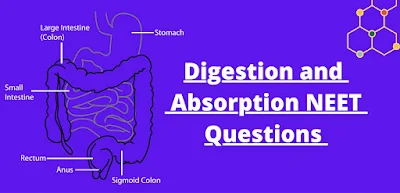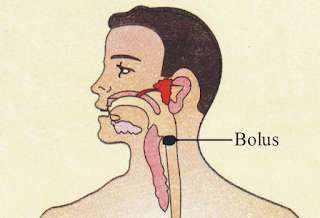Digestion and Absorption NEET Questions :
Digestion and Absorption NEET Questions is Scoring topic where candidates can attempt to solve maximum number of accurate questions and increase their overall score count in the NEET exam. Not only in NEET exams but in other competitive exams as well, Digestion and Absorption is considered to be the most scoring Scoring and Simple Chapter. The aim of this Chapter Digestion and Absorption MCQ is to test candidates’ awareness and knowledge regarding the Digestion and Absorption of food in Humans.
These MCQ on Digestion and Absorption for class 12 Pdf Download will help students score in the upcoming NEET exam and perform better in competitive exams, such as CET, NET, SET. Hence, it is suggested to students to solve all these Digestion and Absorption NEET MCQs with their problem-solving skills and cross-check the answers. Also, try to maintain a time limit for each question. Below is the list of all the Digestion and Absorption multiple choice questions. Here you can get the MCQs with answers and also download PDFs provided for each topic for extra MCQs on Digestion and Absorption to practise more.
Digestion and Absorption NEET Questions Pdf :
1. Which of the following gastric cells indirectly help in erythropoiesis ?
(1) Chief cells
(2) Mucous cells
(3) Goblet cells
(4) Parietal cells
Answer: 4
Read : Diversity in Living World NEET Questions
2. Which has maximum pH ?
(1) Saliva
(2) Gastric juice
(3) Blood
(4) Black coffee/Urine
Answer: 3
3. First enzyme involved in complex carbohydrate metabolism is_______
(1) Salivary amylase
(2) nuclease
(3) rennin
(4) lingual lipase
Answer: 1
Read : Excretory Products and their Elimination NEET MCQ
4. Which one of the following pairs of the type of cells and their secretion is correctly matched_____
(1) Oxyntic cells – a secretion with pH between 1.2 and 3.0
(2) Alpha cells of Islets of Langerhans – secretion that decreases blood sugar level
(3) Kupffer cells – a digestive enzyme that hydrolyses nucleic acids
(4) Sebaceous glands – a secretion that evaporates for cooling
Answer: 1
5. Vitamin-B2 is prosthetic group of____
(1) Haemoglobin
(2) FAD (Flavin Adenine Dinucleotide)
(3) NAD (Nicotinamide Adenine Dinucleotide)
(4) Haemocyanin
Answer: 2
Read : Human Reproduction NEET Questions
6. During old age, muscles and bones becomes weak due to deficiency of_____
(1) Vitamin-D
(2) Vitamin-C
(3) Vitamin-K
(4) Vitamin-B
Answer: 1
7. What is the real sense inflected in the given diagram ?
(1) Closure of oesophagus for the entry of food in stomach
(2) Closure of trachea by epiglottis for preventing food to enter in it
(3) Movement of bolus in trachea
(4) Movement shown is a reflex action
Answer: 4
Read: Human Health and Disease NEET MCQ
8. a-amylase, secreted by pancreas, digest_____
(1) starch
(2) lipids
(3) nucleic acids
(4) proteins
Answer: 1
9. Which one of the following is a fat-soluble vitamin and its related deficiency disease ?
(1) Calciferol – Pellagra
(2) Ascorbic acid – Scurvy
(3) Retinol – Xerophthalmia
(4) Cobalamine – Beri-ber
Answer: 3
Read: MCQ on Locomotion and Movement
10. The initial step in the digestion of milk in humans is carried out by ?
(1) Lipase
(2) Trypsin
(3) Rennin
(4) Pepsin
Answer: 3
11. Gastric juice of infants contains__________
(1) nuclease, pepsinogen, lipase
(2) pepsinogen, lipase, rennin
(3) amylase, rennin, pepsinogen
(4) maltase, pepsinogen, rennin
Answer: 2
Read : Microbes in Human Welfare MCQ
12. In the stomach, gastric acid is secreted by the_______
(1) gastrin secreting cells
(2) parietal cells
(3) peptic cells
(4) acidic cells
Answer: 2
13. Which of the following guards the opening of hepatopancreatic duct into the duodenum ?
(1) Semilunar valve
(2) Ileocaecal valve
(3) Pyloric sphincter
(4) Sphincter of Oddi
Answer: 4
Read : Morphology of Flowering Plants NEET MCQ
14. Which hormones do stimulate the production of pancreatic juice and bicarbonate?
(1) Cholecystokinin and secretin
(2) Insulin and glucagon
(3) Angiotensin and epinephrine
(4) Gastrin and insulin
Answer: 1
15. Pancrease secretes_________
(1) Steroid hormones only
(2) Protenacious hormones only
(3) Both steriods and peptide hormones
(4) None of these
Answer : 2
16. Choleocystokinin (CCK) helps in secretion of_________
(1) Alkaline buffer
(2) Pancreatic enzymes
(3) Gastric secretion
(4) Water and bicarbonate ions
Answer : 2
17. Which cells of "Crypts of Lieberkuhn" secrete antibacterial lysozyme ?
(1) Paneth cells
(2) Zymogen cells
(3) Kupffer cells
(4) Argentaffin cells
Answer : 1
18. Which of the following options best represents the enzyme composition of pancreatic juice ?
(1) amylase, pepsin, trypsinogen, maltase
(2) peptidase, amylase, pepsin, rennin
(3) lipase, amylase, trypsinogen, procarboxypeptidase
(4) amylase, peptidase, trypsinogen, rennin
Answer : 3
19. A baby boy aged two years is admitted to play school and passes through a dental check - up. The dentist observed that the boy had twenty teeth. Which teeth were absent?
(1) Canines
(2) Pre-molars
(3) Molars
(4) Incisors
Answer : 2
20. Bile juice is secreted by stimulation of________
(1) Gastrin
(2) Secretin
(3) Estrerokinase
(4) CCK
Answer : 4
21. If the pH of duodenum decreases below 5, than secretion of _______ stop.
(1) Secretin
(2) Enterokinase
(3) CCK
(4) Gastrin
Answer : 4
22. Match the Following__________
(1) A-v, B-iii, C-i, D-ii, E-iv
(2) A-iii, B-v, C-i, D-iv, E-ii
(3) A-iv, B-iii, C-ii, D-i, E-v
(4) A-ii, B-v, C-i, D-ii, E-iv
Answer: 2
23. Which of the following terms describe human dentition ?
(1) Thecodont, Diphyodont, Homodont
(2) Thecodont, Diphyodont, Heterodont
(3) Pleurodont, Monophyodont, Homodont
(4) Pleurodont, Diphyodont, Heterodont
Answer : 2
24. Which one of the following pairs of food components in humans reaches the stomach totally undigested?
(1) Starch and cellulose
(2) Protein and starch
(3) Starch and fat
(4) Fat and cellulose
Answer: 4
25. A young infant that feed entirely on mother's milk which is white in colour but the stools which the infant passes out is quite yellowish. This yellow colour due to ?
(1) Pancreatic juice poured into duodenum
(2) Intestinal juice
(3) Bile pigments passed through bile juice
(4) Undigested milk protein casein
Answer: 3
26. Which is true about gastric glands ?
(1) Peptic cells secrete pepsin
(2) Oxyntic cells secrete HCl and castle's intrinsic factor, those are responsible for vit B12 absorption.
(3) Mucous cells secrete mucous and intrinsic factor responsible for vit B12 absorption.
(4) Pepsinogen digests protein into peptons and proteoases.
Answer: 2
27. A young person is suffering from cancer in tongue. His tongue is completely removed, then which of the following situation will describe the person that he will be able to________
(1) Taste sweet & salty.
(2) Not able to taste sweet, but able to tastesalty.
(3) Perceive the odour of rose but not able to taste sweet and salt.
(4) Taste sweet and salty, but not perceive to the odour of rose.
Answer: 3
Digestion and Absorption NEET Questions and Answers Pdf Download :
1. Identify the false statement ?
(1) bile is secreted by gall bladder
(2) fundic stomach is the site of digestion
(3) parietal cell lie in wall of stomach
(4) bile is secreted by liver
Answer: 1
2. What is the important function of bile-
(1) For digestion by emulsification of fats
(2) Elimination of excretory products
(3) For digestion by enzymes
(4) Coordination of digestive activities
Answer: 1
3. Some proteolytic enzymes are_________
(1) Trypsin, Erepsin, Pepsin
(2) Amylase, Lipase, Zymase
(3) Ampylopsin, Steapsin, Ptyalin
(4) Urease, Dehydrogenase, Zymase
Answer:
4. Which part of body secretes the hormone secretin?
(1) stomach
(2) oesophagus
(3) illeum
(4) duodenum
Answer: 4
5. Gluconeogenesis is_________
(1) formation of ammonia from glucose
(2) breakdown of glucose
(3) formation of glycogen
(4) formation of glucose from sources other than carbohydrate
Answer: 4
6. Kwashiorkar disease is due to deficiency of_________
(1) protein
(2) fat
(3) sugar
(4) hormone
Answer: 1
7. Select the incorrect statements_______
(a) alimentary canal begins with an anterior cavity called buccal cavity.
(b) tooth is embedded in a socket of mandible bone only.
(c) human shows strict diphyodont type of dentition.
(d) oesophagus and the trachea open into the pharynx.
(1) a, b, c & d
(2) a, b & c
(3) a, c & d
(4) a, b & d
Answer: 2
8. The oesophagus is a thin, long tube which extends _____ passing through the neck.
(1) anteriorly
(2) posteriorly
(3) horizontally
(4) obliquely
Answer: 2
9. In human __________ is a small blind sac, which hosts some symbiotic micro-organism.
(1) Caecum
(2) Colon
(3) Rumen
(4) All of these
Answer: 1
10. Select the odd with respect to enzymes present in adult human.
(1) Rennin
(2) Renin
(3) Trypsin
(4) Pepsin
Answer: 1
11. Which of the following is not produced by the brush border cells of the intestinal mucosa.
(1) dipeptidases
(2) nucleosidases
(2) lipases
(4) steapsin
Answer: 4
12. All of the following is correct w.r.t. large intestine except.
(1) No significant digestive activity.
(2) Absorption of some water
(3) Absorption of certain minerals.
(4) Absorption of remaining glucose and amino acid.
Answer: 4
13. In which of the following disease liver is affected, skin and eyes turn yellow due to the deposit ion of bile pigments__________
(1) Vomiting
(2) Jaundice
(3) Diarrhoea
(4) Dysentry
Answer: 2
14. Select the correct structural sequence of alimentary canal facing from inside to outside.
(1) Serosa -----> Muscularis ------> Submucosa -----> Mucosa
(2) Muscularis -----> Serosa ----> Mucosa -----> Submucosa
(3) Mucosa -----> Submucosa ------> Muscularis -----> Serosa
(4) Submucosa -----> Mucosa ------> Muscularis ------> Serosa
Answer: 3
15. All of the following are correct with respect to intestine of human except.
(1) Colon having ascending, descending and transverse part.
(2) Duodenum is C-shaped structure
(3) Taeneae & haustra is present all along the length of intestine.
(4) Highly developed villi is restricted to small intestine.
Answer: 3
16. Select the correct statements.
(a) Salivary glands situated just outside the buccal cavity.
(b) Liver is the largest digestive gland.
(c) Hepatic duct not arises from gall bladder.
(d) Sphincter of Oddi can regulate the released of pancreatic and bile duct in duodenum.
(1) a, b, c & d
(2) a, b & d
(3) b, c & d
(4) a, b & c
Answer: 1
17. Read the following statements (A-D)
(A) The stomach stores the food for 4-5 hours
(B) The food mixes throughly with the acidic
intestinal juice
(C) Trypsinogen is activated by an enzymeenterogastrone, secreted by the intestinal mucosa
(D) Renin is enzyme found in gastric juice of infants which helps in digestion of milk protein
How many of the above statements are wrong ?
(1) Four
(2) One
(3) Two
(4) Three
Answer: 4
18. Which of the following statements is/are incorrect regarding digestion and absorption of food in human beings_________
(a) About 90% of starch is hydrolysed by salivary amylase in our oral cavity
(b) Entero-endocrine cells in our stomach secrete the proenzyme trypsinogen
(c) Vitamin-D is produced in human body in skin
(d) Bile salts act as activator of pancreatic lipase
(1) Two, a and b
(2) Two, a and c
(3) Two, a and d
(4) Three, a, b and d
Answer: 1
19. In mammals the teeth are_______
(a) of different types
(b) embedded in the cuplike socket in the jaw bones
(c) two sets present throughout life
The condition are referred as :
(1) heterodont, thecodont, diphyodont
(2) thecodont, heterodont, diphyodont
(3) diphyodont, thecodont, heterodont
(4) heterodont, diphyodont, thecodont
(5) thecodont, diphyodont, heterodont
Answer: 1


